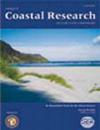旋花科(Convolvulaceae)中较少为人所知的物种(Ipomoea imperati):斯里兰卡贾夫纳 Manalkaadu 沙丘的首次记录
4区 地球科学
Q3 Earth and Planetary Sciences
引用次数: 0
摘要
ABSTRACT Amarasekara, K.; Perera, C.; Yatawara, M., and Jayasiri, H.B., 2024.旋花科较不知名的物种(Ipomoea imperati):斯里兰卡贾夫纳 Manalkaadu 沙丘的首次记录。沿海研究期刊》,40(4),803-808。夏洛特(北卡罗来纳州),ISSN 0749-0208。沿海沙丘是一些沙质海岸线上动态而脆弱的生态系统。它们通常由各种特殊的花卉和动物支撑。沿海沙丘在温带沿海地区尤为常见,但在热带或亚热带沿海地区较少。2022 年 8 月至 2023 年 5 月期间,利用 50 米×5 米的带状横断面完成了对马纳尔卡杜沙丘生态系统植物群的全面研究。研究区域被划分为九个不同的地点进行系统取样。Ipomoea imperati (Vahl) Griseb.是一种双子叶开花植物,俗称 "萁叶牵牛花",属于卷须科。中叶牵牛花有光滑的蔓生茎,茎上覆盖着交替排列的披针形肉质深绿色叶片,叶片先端有缺刻。在研究地区,御苕花的花期为 2022 年 9 月至 2023 年 3 月,花朵呈漏斗状,花瓣为白色,花心为黄色。在发现该物种的地区,该物种经受住了较高的基质温度(约 29°C 至 35°C)、沙土冲刷和中度的沙土堆积掩埋。在 9 个取样点中,有 5 个地点发现了 I. imperati。此外,还分析了植物密度(2 至 6)、植物百分比频率(40% 至 60%)、香农维纳多样性指数(0.54 至 1.43)、物种均匀度(0.50 至 0.90)和物种丰富度(2 至 5)。因此,在五个取样地点,I. imperati 的密度被认为是中等的,而多样性则非常低。在《2020 年国家红色名录--斯里兰卡植物区系保护状况》中,I. imperati 被列为濒危物种。本文章由计算机程序翻译,如有差异,请以英文原文为准。
Lesser-Known Species (Ipomoea imperati) from the Convolvulaceae Family: First Record from the Manalkaadu Sand Dunes of Jaffna, Sri Lanka
ABSTRACT Amarasekara, K.; Perera, C.; Yatawara, M., and Jayasiri, H.B., 2024. Lesser-known species (Ipomoea imperati) from the Convolvulaceae family: First record from the Manalkaadu sand dunes of Jaffna, Sri Lanka. Journal of Coastal Research, 40(4), 803–808. Charlotte (North Carolina), ISSN 0749-0208. Coastal sand dunes are dynamic and fragile ecosystems found along some sandy shorelines. They are typically supported by a wide variety of specialized floral and faunal life. Coastal sand dunes are especially common in temperate coastal areas but are less abundant in tropical or subtropical coasts. A comprehensive study of flora in the Manalkaadu sand dune ecosystem was completed from August 2022 to May 2023, using 50-m × 5-m belt transects. The study area was divided into nine distinct locations for systematic sampling. Ipomoea imperati (Vahl) Griseb., a dicotyledonous flowering plant commonly known as fiddle-leaf morning-glory of the Convolvulaceae family, was recorded for the first time in the Manalkaadu sand dunes of the Northern Province in Sri Lanka during the study. Ipomoea imperati has smooth trailing stems that are covered with alternately arranged lanceolate, fleshy dark green leaves with a notched apex. Ipomoea imperati bloomed from September 2022 to March 2023 in the study area, and the funnel-shaped flowers were fused with white petals and yellow centers. In the area where it was discovered, the species withstood high substrate temperatures (about 29°C to 35°C), sand scouring, and moderate burial by accreted sand. Out of nine sampling locations, I. imperati was found in five locations. The plant density (two to six), plant percentage frequency (40% to 60%), Shannon Wiener diversity index (0.54 to 1.43), species evenness (0.50 to 0.90), and richness (2 to 5) were also analyzed. Thus, the density of I. imperati in five sampling locations was considered to be moderate, whereas the diversity was very low. It is designated as endangered in the National Red List 2020—Conservation Status of the Flora of Sri Lanka.
求助全文
通过发布文献求助,成功后即可免费获取论文全文。
去求助
来源期刊

Journal of Coastal Research
地学-地球科学综合
自引率
0.00%
发文量
87
审稿时长
3-8 weeks
期刊介绍:
The Journal of Coastal Research (JCR) is one of the leading international journals for coastal studies and processes, and is published bi-monthly by the Coastal Education & Research Foundation [CERF]. By covering the entire field of coastal research, the JCR encompasses all subjects relevant to natural and engineered environments (freshwater, brackish, or marine) and the protection/management of their resources in the vicinity of coastlines of the world. Even though the journal broadly focuses on immediate shoreline zones, the JCR also embraces those coastal environments that either reach some indefinite distance inland or that extend seaward beyond the outer margins of the sublittoral (neritic) zone. The JCR disseminates accurate information to both the public and research specialists around the world on all aspects of coastal issues in an effort to maintain or improve the quality of our planet''s shoreline resources.
 求助内容:
求助内容: 应助结果提醒方式:
应助结果提醒方式:


